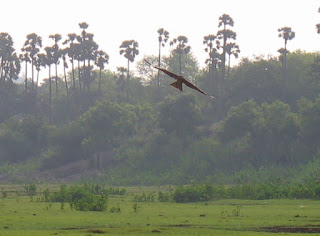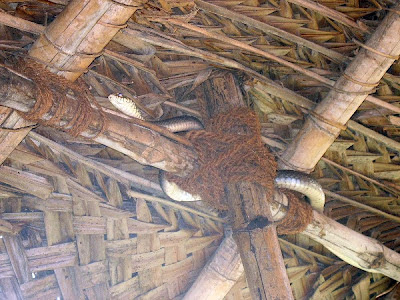The Mountain Imperial Pigeon is not found in this area, however I am posting this beautifully written post (author unknown) as the problems described which are facing the Mountain Imperial Pigeon, are also problems facing our own indigenous birds here in Tiruvannamalai District.
"Our countryside, too, is becoming bereft of their green cousins, as
grand banyans and other fruit trees vanish along our widening roads, and
diverse forests of native trees are replaced by miserable Australian
acacias and eucalyptus, if they are replaced at all. As their homes are
whittled away, the hornbills, barbets, and other pigeons vanish
silently. With them vanish subtle splendours and prospects of
regeneration. On the roads, the vehicles speed along on their wheels of
progress, carrying passengers of a different kind, barely aware of the
majesty and opportunity for renewal left behind."
Mountain Imperial Pigeon Narrative
There is a modesty in their conquest of mountains. From the heights, they commandeer vistas of rugged mountains covered in forest or countryside dotted with great trees. From tall trees on high ridges, they scan the landscape, their heads turning on long and graceful necks. They have scaled peaks, even surpassed them. Yet, they speak only in soft and hushed tones that resonate among stately trees. For, the imperial pigeons are a dignified lot, keeping the company of great trees.
Down in the valley, the pigeon's voice throbs through dense rainforest: a deep hu, hoo-uk, hoo-uk, repeated after long pauses, like the hoots of an owl. In the dawn chorus of birdsong, it sounds like a sedate basso profundo trying to slow the tempo of barbets and calm the errant flutes and violins of babblers and thrushes. The calling pigeon, in a flock with others, is in a low symplocos tree whose branches shine with dark green leaves and purple-blue fruit. They are busy picking and swallowing the ripe fruits, each with fleshy pulp around a single stony seed.
These large birds, neatly plumaged in formal greys and pastel browns, are Mountain Imperial Pigeons — a species found in the rainforests of the Western Ghats and the Himalayas in India. In more open forests and on grand banyan and other fig trees along the roads through the countryside, one can see their cousins, the Green Imperial Pigeons shaded in more verdant sheen. As a group, the imperial pigeons have a penchant for fruit that necessitates roaming wide areas in search of food. Weeks may pass in a patch of forest with no sign of pigeons, but when the wild fruits ripen, the nomadic flocks descend from distant sites and the forest resonates with their calls again.
The Transporter
Like other birds such as hornbills and barbets in these forests, imperial pigeons eat fruits ranging from small berries to large drupes, including wild nutmegs and laurels and elaeocarps (rudraksh). Yet, the pigeon's bill is small and delicate in comparison with the hornbill's horny casque or the barbet's stout beak, which seem more suited to handling large fruits with big stony seeds. The imperial pigeon's solution to this problem is a cleverly articulated lower beak and extensible gape and gullet that can stretch to swallow the entire fruit and seed.
Lured by the package of pulpy richness in fruit, the pigeon then becomes a transporter of seed. Many seeds are dropped in the vicinity of the mother tree itself, scattered around with seeds from rotting fruit fallen on the earth below. The concentrated stockpile of seeds below elaeocarp and nutmeg trees is attacked by rodents and beetles, leaving little hope for survival and germination. But when the pigeon takes wing, some seeds go with the pigeon as passengers on a vital journey, travelling metres to miles into the surrounding landscape. Voided eventually by the pigeon, the dispersed seeds have an altogether greater prospect of escape from gnawing rat and boring beetle and — when directly or fortuitously dropped onto a suitable spot — of germination. By carrying and literally dropping off their passengers where some establish as seedlings and grow into trees, the pigeons become both current consumers and future producers of fruit.
Still, it is the quiet achievement of the trees that seems more impressive. Rooted to a spot, the trees have enticed the pigeons to move their seeds for them. Deep in the forest, one discovers a seedling where no trees of that kind stand nearby, bringing a rare pleasure like an unexpected meeting with an old friend. The pigeons are plied with fruit and played by the trees. The modest conquest of the mountains by the pigeons is trumped by the subtler conquest of the pigeons by the immobile trees.
Peril of Extinction
In speaking of the pigeon's passengers, one recalls with misgiving the fate of Passenger Pigeons. The Passenger Pigeon was once found in astounding abundance across North America in flocks numbering tens of millions — flocks so huge that their migratory flights would darken the skies for days on end. Yet, even this species was exterminated by unmitigated slaughter under the guns of hunters and by the collection — during their enormous nesting congregations — of chicks (squabs) by the truck-load. Within a few decades, the great flocks and society of Passenger Pigeons were decimated in vast landscapes transformed by axe and plough, plunder and profiteering. By 1914, the species — at the time perhaps one of the most abundant land bird species in the world — had been reduced to a single captive female. The last known Passenger Pigeon, Martha, died in Cincinnati Zoo in September 1914, closing the page on another wonderful species, in another sorry chapter of human history on Earth.
Our pigeons are more fortunate, but in many areas they, too, are dying a slow death. Some fall to the bullets of hunters who take strange pride in their dubious sport or skill. Some roam large areas of once-continuous rainforests, which now have only scattered fragments. The mountain imperial pigeons are still seen winging across in powerful flight from one remnant to another, over monoculture plantations and stagnant reservoirs. Their forays are getting longer, and their journeys often end fruitless. Our countryside, too, is becoming bereft of their green cousins, as grand banyans and other fruit trees vanish along our widening roads, and diverse forests of native trees are replaced by miserable Australian acacias and eucalyptus, if they are replaced at all. As their homes are whittled away, the hornbills, barbets, and other pigeons vanish silently. With them vanish subtle splendours and prospects of regeneration. On the roads, the vehicles speed along on their wheels of progress, carrying passengers of a different kind, barely aware of the majesty and opportunity for renewal left behind.
From the valley, the imperial pigeons take wing and — in a minute — fly high and swift over the mountain to distant rainforests. There, sometime in the future, new seedlings will perhaps still emerge in a silent testimony. A testimony that one can forever fly high and strong if one only consumes what one also regenerates in perpetuity.












































